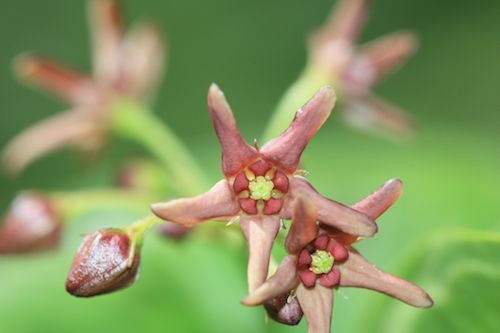Crow’s Nest: Plants we love, plants we don’t…
First, a plant we love is in bloom right now. Half of its name—butterfly weed—is unfortunate, as it is not a weed at all. At least it is never invasive for us, and it is a good native plant for attracting butterflies and bees. Its botanic name is Asclepias tuberosa, and it is in the milkweed family (Apocynaceae). You can see it along the trail through our savanna.

Then there is another plant in the same family that grows in the same meadow that we don’t love so much. It is not ugly in appearance, but it can be a very aggressive invasive plant. Called pale swallowwort (Cynanchum rossicum, synonym Vincetoxicum rossicum) it also goes by the name, “the dog-swallowing vine”—because (as the story goes), if your dog were to run into a patch of it, you might never see him or her again.
I was never sure whether we had pale swallowwort or black swallowwort, but after taking this closeup photo (and upon the counsel of Penn State’s Art Gover) I have become confident that ours is “pale.” It’s not just that the flowers are lighter in maroon color, but the lobes of the corolla are hairless and skinnier compared to black swallowwort’s darker maroon color and broader and pubescent corolla lobes. Both are potentially invasive species but pale swallowwort is only known to grow in a couple locations in Pennsylvania (so far) so our population adds significantly to the geographic data for this species. Yes, I’m aware of the irony of having a “rare invasive.” But knowing that a plant that is invasive elsewhere is now present on the land you manage (or in your county, etc.) is forewarned, forearmed.

You can read a post from 2007 about our swallowwort here, at which time a researcher was studying the soils that are prone to be invaded by swallowworts.
I have submitted an entry for our population of pale swallowwort to the database of the Mid-Atlantic Early Detection Network (MAEDN) for invasive plants. The purpose is to alert land managers and officials that a species of invasive plant is now becoming present in the region so that management efforts can be initiated while control is still possible. Expert verification is required for each entry; photographs and a map accompany each record.
Posted by Daniel Barringer on June 12, 2012.
